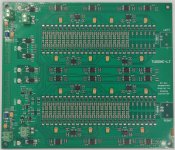We did a listening day to compare various dacs....
Thanks for sharing.
The real danger is in spending all that extra money required to make a DIY DAC sound decent... and then realising that for the same money.... you could have bought something that sounds really great out of the box.
However, for a true DIY-er..... learning, experimenting (and money spending) is all that counts and there's simply no other way.
What does this mean exactly?
IIRC True Sync was a term coined by Twisted Pear. So far as I can tell it just means that the DAC is set in synchronous mode using the master_div bits and DPLL_Bandwidth is set to zero.
Dunno. Are we talking something like this: https://www.kitsunehifi.com/product/holo-audio-may-dac/ plus adding an SOA PC (with SOA video card) to use HQ Player PCM to DSD1024 conversion at the highest quality settings?...for the same money.... you could have bought something that sounds really great out of the box.
The reason I asked was that Buffalo firmware does not work that way. It does not set 128fs mode, master_div bits or DPLL bandwidth to zero.
https://github.com/twistedpearaudio/Buffalo-III-SE-Pro-On-Board-Firmware/blob/master/Buffalo.c
https://github.com/twistedpearaudio/Buffalo-III-SE-Pro-On-Board-Firmware/blob/master/Buffalo.c
Code:
// we don't ever want the DPLL to be off
if (dpll == 0) dpll = 5;This review seems tendentious to say the least. The DIYINHK board is not very good and the implementation with Bisesik(?) transformers is very "audiophile". Twisted pear lego-approach is also non-optimal. So the only conclusion to draw is that ES9038PRO is not suitable for audiophile mods.
Why not make this more relevant and use a proper ES9038PRO implementation such as Topping D90SE in the comparison.
Why not make this more relevant and use a proper ES9038PRO implementation such as Topping D90SE in the comparison.
...as the IV stage is integrated into Andreas discrete...
Not seeing a clear IV stage in the pic below. Looks more like direct out from the resistor array.
Attachments
...Buffalo firmware does not work that way. It does not set 128fs mode, master_div bits or DPLL bandwidth to zero.
Have a feeling that there may have been a special version of the firmware to support True Sync.
Current-out R2R array loses linearity if the output voltage deviates even slightly from zero. Thus I'd hazard it makes more sense measurement-wise to go voltage-out R2R and employ a buffer.Not seeing a clear IV stage in the pic below.
The real danger is in spending all that extra money required to make a DIY DAC sound decent... and then realising that for the same money.... you could have bought something that sounds really great out of the box.
However, for a true DIY-er..... learning, experimenting (and money spending) is all that counts and there's simply no other way.
The good thing is most of us are not hamstrung by conventional common sense 🙂
Per example it seems very hard to match dollar for dollar the sound quality of a Denafrip's discrete dac using discrete modules available to the diyer. Has that stopped anyone?
I think if you want to get decent sound out of an ESS DAC, you need to as a minimum upsample prior to bypass the average oversampling filters and avoid the internal volume control which to me, sounds grainy and flat.Seems the listening panel's tastes were all geared towards NOS...
If you can upsample to 352/384, run in OSF bypass mode, run in True Sync to bypass the DPLL and go PCM interface directly to HyperStream DAC. It gets much better, but it's a lot of work..
The review did not include any measurements but for the DIYINHK ES9038PRO with Bisesik transformers this will probably look very similar. I don't really get the point of using transformers with ES9038 to get such added distortions and other artefacts. But surely properly implemented ES9038PRO with 120dB SINAD will sound dull and bland in comparison 😉
Agreed. The D90SE is a known standard that measures super low distortion, is reasonably cost effective and has a decent user base.This review seems tendentious to say the least. The DIYINHK board is not very good and the implementation with Bisesik(?) transformers is very "audiophile". Twisted pear lego-approach is also non-optimal. So the only conclusion to draw is that ES9038PRO is not suitable for audiophile mods.
Why not make this more relevant and use a proper ES9038PRO implementation such as Topping D90SE in the comparison.
It would also be worth throwing a top line MB DAC such as MSB or Holo May. This is the area Andrea is playing in.
Joseph K once wrote to me that the D90 uses individual ADP7112's for each Vref channel, and that "the noise density spectra of the ADP7112 is.. scary..". Looking in the datasheet, it seems to use a voltage reference with a very high impedance, integrated low-pass filter, causing lots of subsonic noise. In a DAC, that causes noise skirts around the signal.
For a flagship product I find it rather strange that Topping presumably left out the SRC (AK4137) as the spdif inputs have typical AK4118 jtest "signature" in ASR review.Happen to have a Topping D90 (AK4499 version). Close enough?
...D90 uses individual ADP7112's for each Vref channel...
It uses them as secondary regulators with a lot of filter capacitance after. IIRC the voltage drop across those regulators is quite low, less than 1v. Don't know if they are operating in their normal region. Primary Vref regulators are SMD 317's.
Wouldn't expect a preregulator to help that in most cases. However, IIRC ADP7112's were running near dropout. Don't know what effect that might have. Might have been right around 200mV differential from input to output. Based only on vague memory of being surprised about it, don't think I kept a measurement note.
- Status
- Not open for further replies.
- Home
- Source & Line
- Digital Line Level
- The battle of the DACs, comparison of sound quality between some DACs
